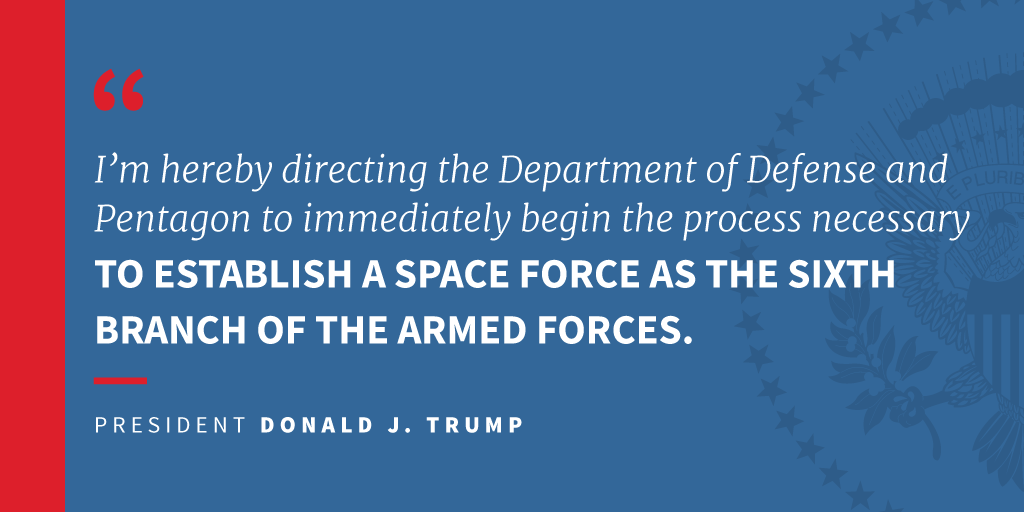Five Principles To Drive The Space Force
Posted on

Now the real work begins on the Space Force, the biggest reorganization of the U.S. armed forces in decades.
The business world has long “spun off” and “carved out” new businesses as a routine part of corporate strategy. Successful divestitures over the last 20 years include Hewlett-Packard’s carve-out of Agilent, CBS’s split with Viacom, and the separation of eBay and PayPal. When these happen with sufficient planning, strategy, and resources, the new entity is positioned for success, while the parent organization emerges with a renewed focus on its core missions and the increased strength to execute them.
The Space Force can use some of these lessons.

Troy Thomas
To be clear, about half of all private-sector divestments lose value, and many of the most common risks of carve-outs in the private sector also apply to the military. Like most large companies, the Defense Department and each of the four military services must guard against disruptions to operations during the transition. Other operational risks include orphaned or weakened functions that emerge when important flows and connections are severed. Fiscal risks include hidden or “stranded” costs. And, if poorly managed, brand and reputational risks can negatively affect recruitment, retention, and employee engagement.
To avoid these risks, senior defense leaders should apply five best practices that have proven their worth in the private sector.
Offer A Clear Vision And Strategy Commercial carve-outs succeed when the new and parent organizations can articulate a compelling purpose and role for their respective entities, with explicit responsibilities, objectives and criteria. For the Air Force, as well as for the other services that will transition some of their space capabilities, the challenge is to create a differentiated strategic vision for the future entities with clear boundaries between them. Regardless of the final form of the new branch—and much is still to be determined—the Department of the Air Force, and the Air Force itself, must seek to exit the carve-out as strong, if not stronger, than in its current form with is mission set clearly defined. Getting this right will enable other important strategic outcomes to include improving readiness, retaining critical talent, optimizing modernization investments, and strengthening the culture.
Prepare The Organization In our experience, most successful carve-outs happen quickly—execution occurs within a few months of the official closing date. That kind of execution speed isn’t possible without 9 to 12 months of advance planning, including a new organization design and a blueprint for implementation (with a communications plan). During this advance planning period, leaders need to thoroughly assess all functions of the organization, looking at human capital, physical assets, intellectual property, IT systems, organization structure and processes, acquisitions and contracts, and policy. A thorough cataloging of all functions, services, and products is critical to knowing what to retain, transition, or transform.

US Air Force Space & Missile Systems Center (SMC)
Define Who Does What, And With What Once the boundaries between the parent and the new organizations are defined, the Air Force and other affected services must complete a comprehensive review of all of the shared assets and processes across the existing and future organizations. These can be surprisingly complex, and few management teams can anticipate them all. (In particular, many organizations underestimate the time and cost required to address IT.) A best practice is to form a cross-functional team to clearly define which assets are shared today, what it will take to separate them, and the time and date by which they need to be separated. In some cases, it will be necessary to create new Memorandums Of Understanding (MOU) and Service Level Agreements (SLA) to better manage resources and expectations during transition.
Decide If You’ll Transition Or Transform Organizations have two options when designing a carve-out: to “lift and shift” or to transform. “Lift and shift” entails spinning off the new organization while leaving the parent organization essentially unchanged in its design and operating model. This is a faster path, one aimed at minimizing potential disruptions. In contrast, the transformation approach requires designing the new organization while also redesigning the parent organization, leading to larger gains. This can be a particularly useful approach if the organization is historically slow to change. The Air Force should be ambitious and innovative in improving its current operating model, using this transition as a chance to shake up entrenched hierarchies, accelerate decision processes, remove low value-added work and implement a more agile organization.
Communicate With Personnel The success of the new Space Force and current military services depends on maintaining key personnel throughout this period of transition. Poorly handled carve-outs can be stressful experiences that lead to poor morale, declines in productivity, and a loss of key talent. In our experience, the best approach is early, frequent, and transparent communications with clarity on opportunity for development. The workforce will have significant concerns about their future roles, reporting structure, place in the organization, and growth and learning opportunities. The quicker the organization can answer these questions, the greater its likelihood of maintaining talent.
In sum, the creation of a new branch of the armed forces is a big job, driven by real strategic imperatives, that is as much an opportunity as it is an obligation. If done right—by applying the business-tested lessons learned from commercial carve-outs and divestitures—the creation of the Space Force will ensure that it, the Air Force, and the rest of the DoD enterprise, emerge stronger than ever, and better equipped to execute their respective missions while securing a competitive advantage in space.
Troy Thomas, now with Boston Consulting Group, was the National Security Council’s senior director for defense policy and strategy. He also served as special assistant to the Chairman of the Joint Chiefs of Staff. Lacy Ketzner is a partner and managing director at BCG with experience in the aerospace sector.
Subscribe to our newsletter
Promotions, new products and sales. Directly to your inbox.
